Deciding how to replace missing teeth in your mouth can be an overwhelming process. Not to mention, an affordable option can mean $100 for someone, while $20,000 may be reasonable for someone else.
In this post, we want to cover all the tooth replacement options that we offer at Monfredi Family Dental (MFD), and the pros and cons of each. You’ve got questions – this post has all the answers.
When deciding how to replace missing teeth in your mouth, we have a few different categories
- Replacing a single tooth (without an implant)
- Removable Partial Denture (Metal or Valplast-Based)
- Flipper
- Dental Bridge
- Replacing a single tooth (with an implant)
- Single Tooth Implant
- Replacing multiple teeth (without implants)
- Removable Partial Denture (Metal or Valplast-Based)
- Dental Bridge
- Removable Full Denture
- Replacing multiple teeth (with implants)
- Removable Overdenture
- Fixed Hybrid
We’ll start at the top and work our way through the options.
Options to replace a missing tooth without an implant
A Removable Partial Denture (Metal or Valplast-Based)
A removable partial denture can be freely placed into and taken out of your mouth during the day and this appliance has the ability to replace either 1 or multiple teeth in your mouth. There are 2 types.
A Metal-Based Partial
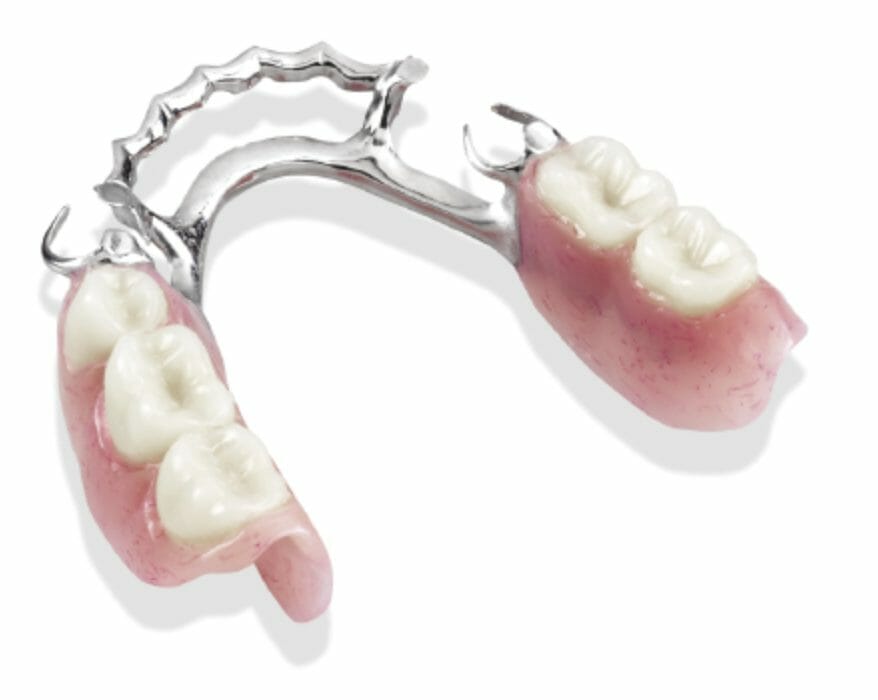
A Valplast-Based Partial
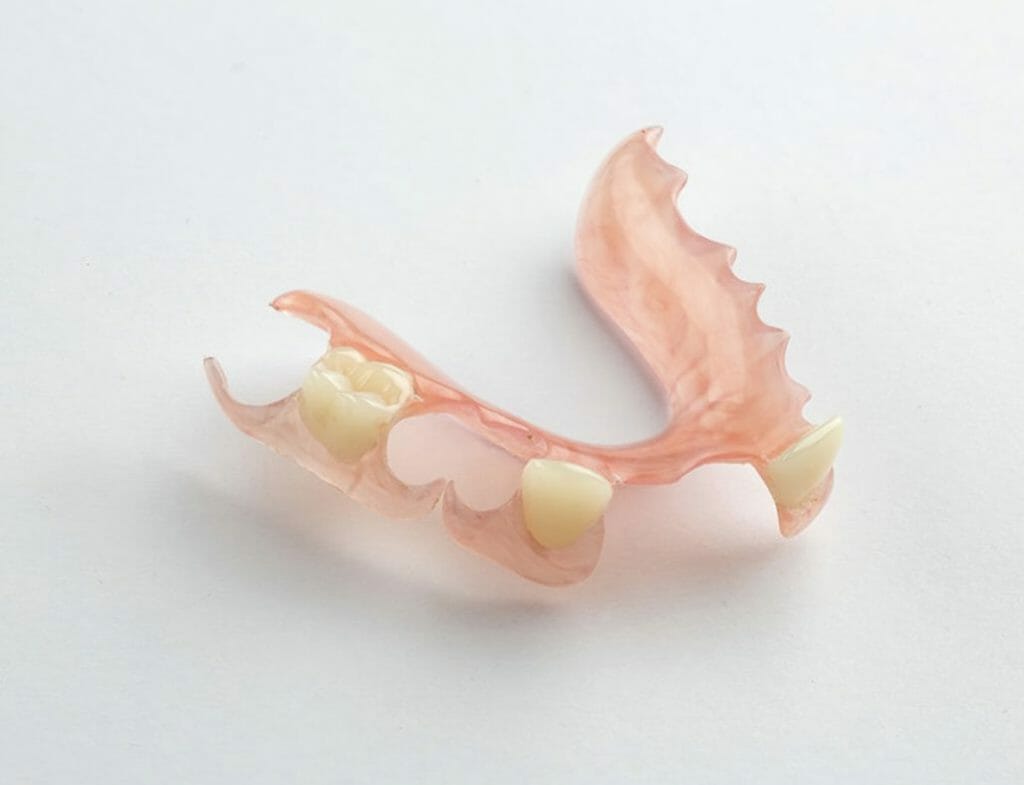
It is important to rinse off and take out either partial after eating because food can get caught underneath the clasps (or the appliance itself) and cause decay if left without cleaning.
Comparing the two partial denture types
The metal-based partial is more durable and easier to add additional teeth to in the future. However, some patients don’t like the look or feel of the metal in their mouth, and the metal-based partial will clasp to existing teeth in your mouth with the metal components.
Some patients enjoy wearing the flexible partial better because it is more comfortable to wear – part of the reason being there are no metal clasps. The appliance itself is made to fit your teeth and gums without a metal junction point. The flexible partial is a sturdy material that should hold up, but it’s not quite as strong as metal.
We have many patients who love their metal and valplast-based partials. But at the end of the day, either partial denture option presents a foreign material in your mouth that can be a lot to wear for some patients. For those patients who’d like a different choice, we can talk about some of the options below.
But before we get ahead of ourselves, we should talk about:
A Flipper
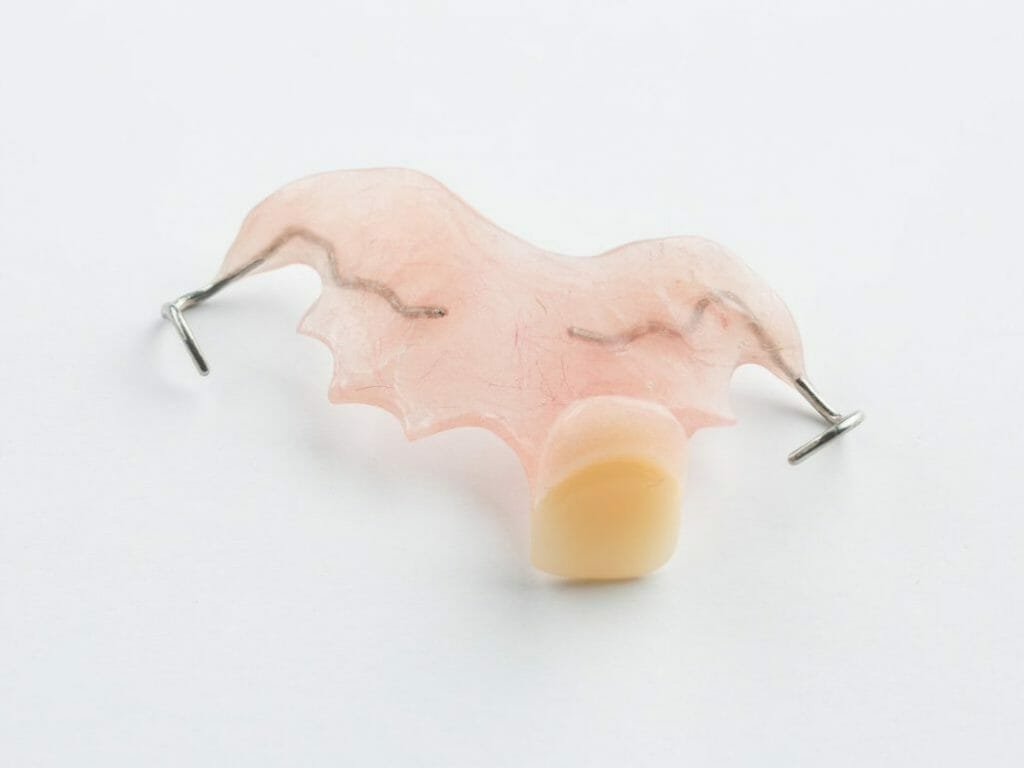
We offer a dental flipper for patients who need a tooth extracted but do not want to wait a few weeks for their permanent tooth replacement option without having the appearance of a tooth in that position.
In that case, we’ll prepare a flipper before having your tooth extracted so that you can walk out of your extraction wearing your flipper.
The flipper is only for looks and you cannot use it to effectively eat. It is designed to be a temporary solution until either your partial, bridge, or other permanent solution is made.
This option is an acrylic-based material that uses metal clasps to attach to nearby teeth. As we talked about above, this is not a durable, long-term solution.
A Dental Bridge
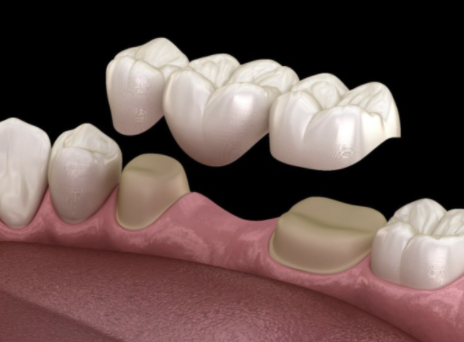
A dental bridge can replace 1 or multiple teeth and we refer to the size of a bridge in terms of units. For example, the picture above represents a 3-unit bridge.
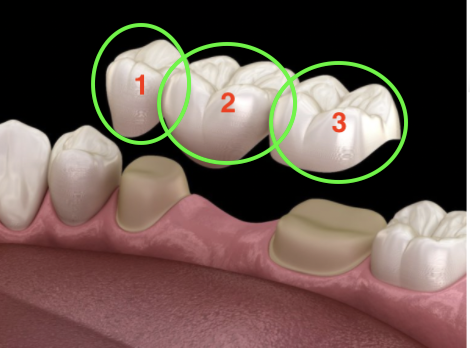
The 3 unit bridge above is used to replace 1 missing tooth by attaching 2 permanent crowns to the teeth around an empty space. Unit #2 above is attached permanently to units 1 and 3, and once the bridge is seated on teeth 1 and 3, unit 2 will sit atop the gum line and give the appearance and function of a normal, healthy tooth.
Before implants became more popular, the dental bridge was the solution to replace a missing tooth. The appeal of a bridge is that it is permanent, and unlike the partials above, the bridge will not come in and out of your mouth.
That being said, you still need to clean around all 3 units above (or more if we are replacing multiple teeth), especially underneath unit #2. Food can easily get caught in the tiny space between your gums and unit 2. It’s critical to keep that area clean and free of debris.
The Main Downside Of A Bridge
Dr. Monfredi will need to shave down both teeth around the missing space in order for the bridge to sit properly on top. If teeth 1 and 3 above are otherwise healthy, removing healthy tooth structure is something we want to avoid, if possible.
Additionally, if you are missing a back tooth, a bridge is not a viable option. We need teeth on both sides of your missing tooth in order to properly anchor a traditional bridge.
Creating and seating a dental bridge is much better than having a missing tooth in your mouth, however, with the advent and progress of dental implants, most times an implant can be a better solution (more below).
Replacing A Single Missing Tooth Using A Dental Implant
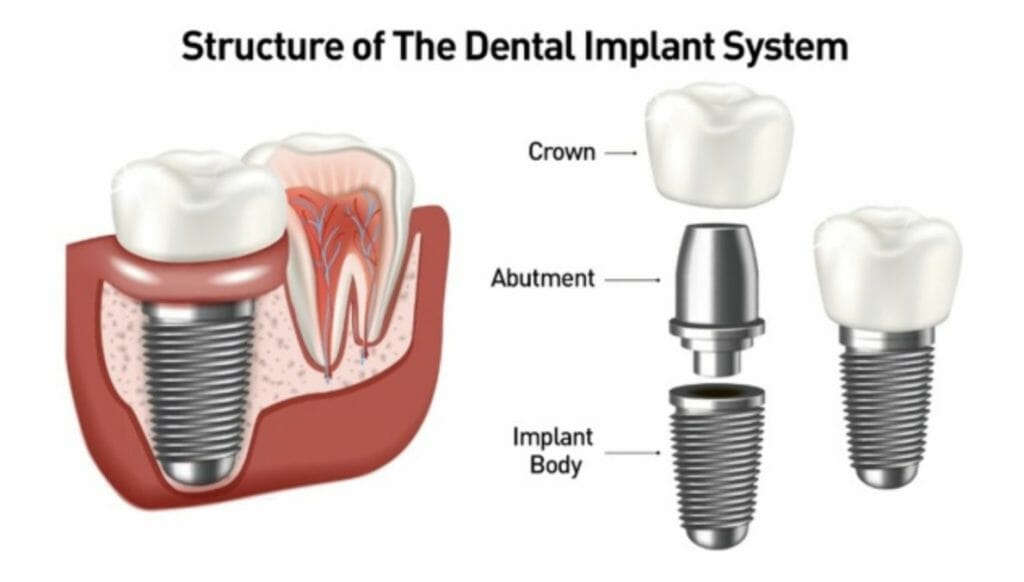
We recommend single-tooth implants in a few scenarios. You may either have a tooth in your mouth that needs to be extracted or you can already be missing that tooth for some period of time.
Immediate vs. Delayed Placement Of A Single Tooth Implant
As long as the bone beneath your tooth that needs to be extracted is in decent shape, most times we can extract your tooth and place the implant during 1 visit. There are some scenarios when we extract the tooth and then see that your bone is not quite stable or healthy enough to support an implant. In that case, Dr. Monfredi or Dr. Fowler may recommend bone grafting.
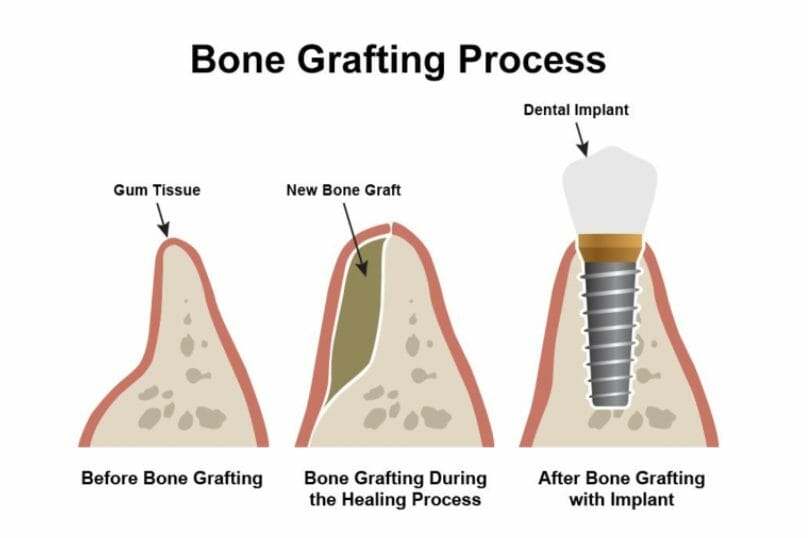
A bone graft – adds volume and density to your jaw in areas where bone loss has occurred. This procedure will help create a more stable foundation for your implant to be placed.
If we need to place a graft, we will extract the tooth, place a graft, and then let you heal for about 3 months. Once that graft is healed, we’ll have you back in the office to place your implant. You will not need to pay for an additional surgery because of this. The only difference in cost will be for the actual graft, itself (we always provide comprehensive estimates for you prior to beginning a procedure).
Restoring Your Implant After It Is Placed
Dr. Fowler, our surgeon, will have you wait either 4 (lower jaw) or 5 months (upper jaw) to load (restore) your implant following surgery.
During those 4 or 5 months, your implant will successfully integrate into your bone. We will verify this has taken place by getting you back into the office for what is called a torque test. Once your implant is tested by Dr. Fowler, he’ll give Dr. Monfredi the go-ahead to begin restoration and ultimately place your permanent crown.
The restorative process consists of 2 visits spaced about 1.5-2 weeks apart. Each of these visits is relatively quick (about 45 minutes). During visit 1, Dr. Monfredi will take some impressions, we’ll send those off to our lab, and then get you back in the office for visit 2 where she will seat your permanent crown.
Your permanent crown can be treated like a natural tooth once placed (e.g. eating, brushing, flossing, etc.).
Options To Replace Multiple Missing Teeth Without Implants
A Removable Partial Denture (Metal or Valplast-Based) Replacing Multiple Missing Teeth
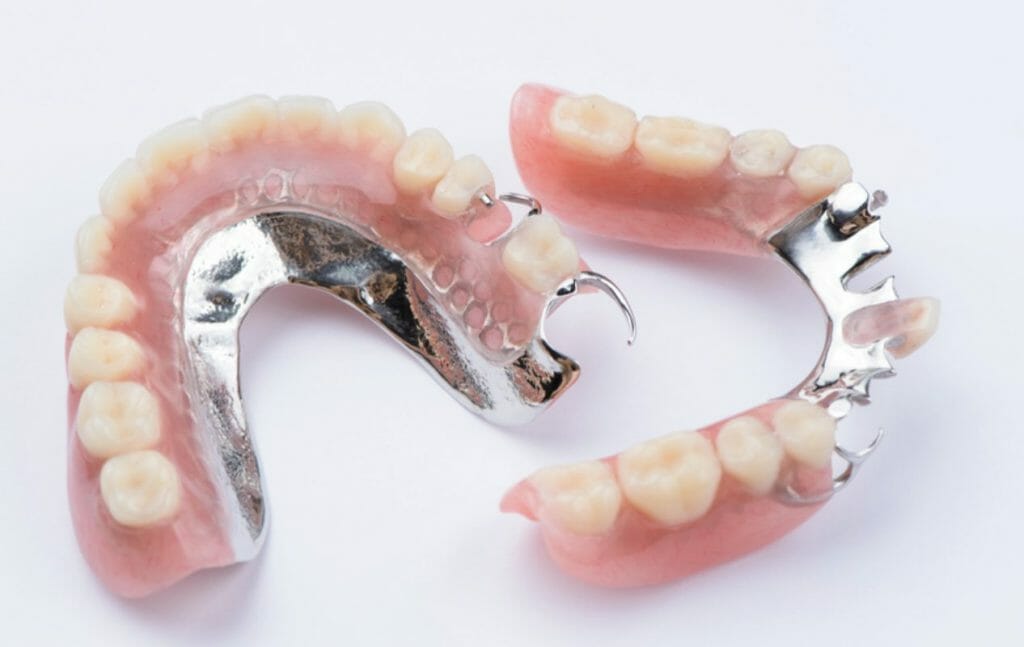
Just like the single-tooth removable metal and valplast-based partials above, we can use the same appliances to replace multiple teeth.
As long as we have enough solid remaining teeth for a partial to attach to, having a partial denture with few remaining teeth is usually better than having no teeth with a full removable denture (more on that below).
In order to determine if your remaining teeth can support a metal or valplast-based partial, we recommend having an exam with Dr. Monfredi so that she can review your current condition and discuss these options as they relate to your unique situation.
A Dental Bridge With 4 Or More Units

Like a 3-unit bridge, a bridge of 4 or more units will also need anchor teeth to support it. Depending on where the missing teeth are in your mouth, as well as how many missing teeth there are will determine whether or not the bridge can be placed.
One thing that we need to place a successful bridge is a 50:50 ratio. Meaning, the roots of your anchor teeth need to be at least equal in size to the roots of the teeth we’re replacing. In molar and premolar teeth, this can be a little easier to do than with front teeth.
Another factor is the strength of your bite. If you have a strong bite, we won’t want to use a bridge to span multiple missing teeth because there is an increased risk that your bridge will break or get damaged.
A Removable Full Denture
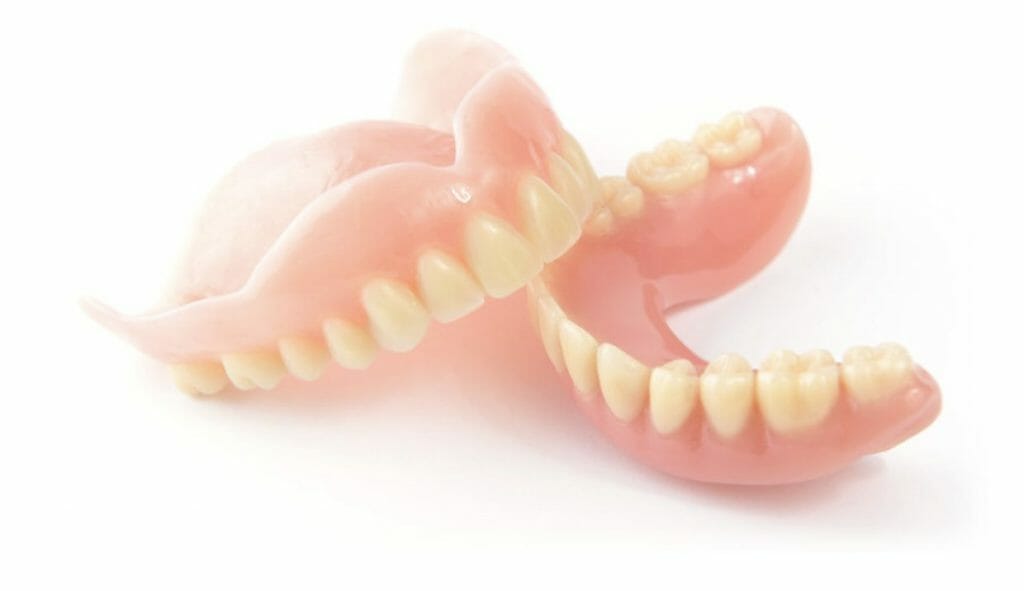
The obvious benefits of full removable dentures are that you will have the appearance of teeth as well as the ability to chew and eat your food. But as Dr. Monfredi reminds us, “Hardly anyone loves the fit of their full dentures.”
Many people believe that removable full dentures are their only option to replace a full arch of missing teeth. This had been the case in the past, but it’s not true today. Financially, this is the most cost-effective option, but as we’ll discuss below, as the implant technology has come further and dramatically improved, there are some clinically better options.
Before we get there, a few points about removable full dentures:
You almost always have to wear paste on your lower removable full denture. Many patients report this being less desirable. Wearing paste can be annoying and awkward in your mouth.
With your full upper denture, many patients don’t like it because it covers your palate which can take away your ability to taste food. Also, if you have a high gag reflex, having acrylic that far back in your mouth can create an issue. We can’t remove the palatal portion of your denture because then we would lose suction and you’d have a more difficult time keeping the denture in place.
Temporary Dentures
This appliance is in a unique category but need to be covered in a comprehensive tooth-replacement post.
Temporary dentures are an appliance made before having your teeth extracted. They are designed to be placed into your mouth immediately after your surgery so that when you walk out of the office, you have the appearance of teeth in your mouth.
This option is defined exactly how its title implies – “Temporary”. The temporary dentures are made for a 2-4 month window while we wait for your mouth to heal so that we can fabricate your permanent, well-fitting dentures. They are also made while you still have teeth in your mouth. For that reason, they are a ‘best guess’ about the gum shape and size of what your mouth will be following surgery.
Drawbacks to temporaries include a likely poor fit, lack of ability to eat with these, and an at times awkward experience.
The benefit to temporaries is simple – you will be able to interact in life while having teeth in your mouth.
Because of the drawbacks outweighing the benefits, temporary dentures are priced accordingly.
Options To Replace Multiple Missing Teeth With Implants
Removable Overdentures (Affixed To Implants)
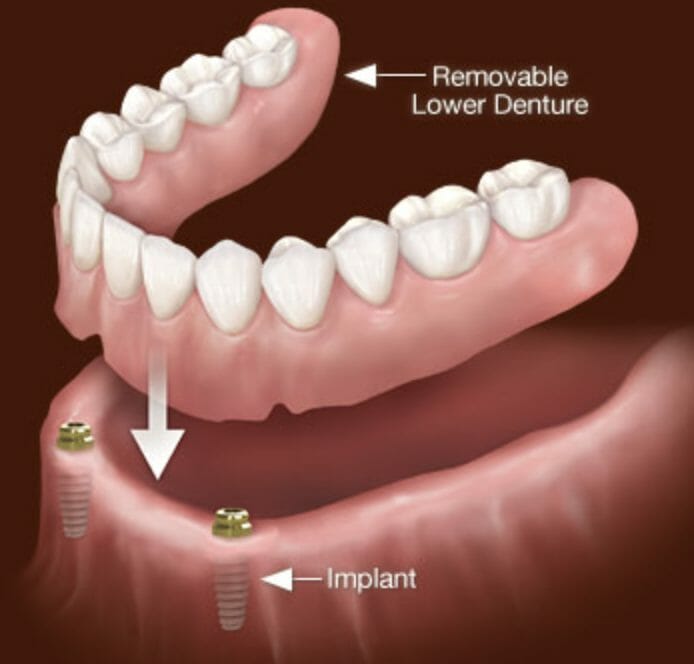
Removable overdentures present a more affordable option to get a better fitting set of teeth (when compared with the option below – the Permanent Hybrid).
Like your removable full dentures, removable overdentures still come in and out of your mouth, but they are attached to 2-4 implants when they’re ‘snapped’ in. These snaps function to better secure your denture and they work just like the snaps on your jacket.
We’ll need to place at least 2 implants in the lower jaw and at least 4 in the upper to achieve the most stable results. Also in the upper, we most often need to keep at least some portion of the palate of your denture in place for the greatest stability of the appliance in your mouth.
Permanent Hybrid / All On 4’s / All On X’s
We have written extensively about the Permanent Hybrid (commonly referred to as All On 4’s) on a different page on the site (click here to read about the Permanent Hybrid or All On 4’s option at Monfredi Family Dental).
In summary, your Hybrid is basically a full bridge that is attached to anywhere from 4-6 implants per jaw.
During the All On X surgery, all remaining teeth in an arch will be extracted, the implants will be placed, and you’ll walk out of surgery with a ‘Long Term Provisional’ (LTP) appliance attached to your implants. In about 4-6 months, you’ll return to the office when Dr. Monfredi will then trade out your LTP for the Permanent Hybrid.
There are many different types of patients who may be great candidates for a Permanent Hybrid, and the benefits are many:
- No tooth replacement option provides a well-functioning, clinically sound denture faster
- Your permanent hybrid is made of zirconia rather than acrylic (stronger & more durable)
- The hybrid has a smaller footprint in your mouth (you don’t lose taste by covering your palate)
- The hybrid does not get taken out at night – it is permanently fixed in your mouth
- Your Permanent hybrid will not “rock” or move in your mouth
The trade-offs for these benefits are few but relevant – this is more complex surgery than placing a couple of implants and for that reason, the costs are typically greater.
When It Comes To Replacing Missing Teeth… You Have Options
In this post, we outline many options when it comes to replacing the missing teeth in your mouth. If you’re overwhelmed, have no fear. We’re here to help talk through the options with you, weighing the pros and cons based on your unique goals and oral health.
The first step… just give us a call to set up your initial consultation. We’ll help with the rest!


